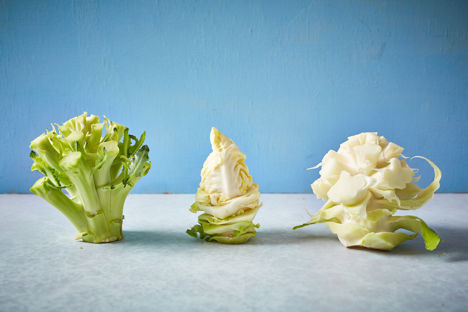
Waste away: stems
Tough and fibrous stalks and stems are usually stripped of their florets or leaves and consigned to the bin – but it doesn't have to be that way. Victoria Glass shows us how they can become the star of three delicious recipes.
Waste away: stems
Tough and fibrous stalks and stems are usually stripped of their florets or leaves and consigned to the bin – but it doesn't have to be that way. Victoria Glass shows us how they can become the star of three delicious recipes.
From the bony ribs of kale to the stumpy legs of broccoli, vegetable stems are overflowing food waste caddies up and down the country. And what a terrible shame that is for our dinners, not to mention our wallets. The stems may be a little tougher and a touch more fibrous, but when shown a little love and care, you can get twice as much out of your ingredients.
In researching my cookbook, Too Good To Waste, I found myself weighing a lot of vegetables. It turns out that a little over half the weight of an average-sized cauliflower or broccoli is made up of the leaves and stem. This means if, like many others, you only eat the florets, you are wasting more than you are eating and essentially tossing away half the money you spent on them. This imbalance is even more marked if you trim off all but their mossy tops, leaving behind a stump of stalk, like an over-pruned tree, untouched in a puddle of gravy.
This waste particularly pains me because the stems are my favourite bit. This isn’t about dutifully swallowing something unpalatable for the sake of saving the environment – as noble as that motivation might be. The core of a cabbage or the stalk of a cauliflower or broccoli, when eaten raw (either shaved or finely sliced), is crunchy and refreshing, with a subtle bitterness that works wonderfully in a salad and can stand up to robust flavour pairings – think anchovy vinaigrette or blue cheese dressing. When cooked through, they are tender and the taste is milder, like a radish crossed with asparagus.
All those squandered stems could become the heart of an extremely enjoyable supper; simply trimmed and roasted with oil, salt, cumin and chilli flakes, grated and turned into fritters, or simply cut into batons and steamed to be eaten as a simple side vegetable along with the rest of the plant. Try cutting them into fine matchsticks to stir-fry, dip them in batter for first-rate vegetable tempura, or simply chop and add to soups, though don’t cook them for too long. It’s over-boiling that releases a sulphurous scent, which is why brassica stems aren’t the best choice to save for stocks. Chard stems and even the discarded cobs from sweetcorn, however, make brilliant bases for vegetable stocks.
Kale stems and cabbage cores make for a fantastic ferment, so get your sauerkraut and kimchi jars ready to liven up lunchtime (albeit after a few weeks’ wait). Kale juice has been making complexions glow for at least the last decade, and now that a super-duper high-powered blender is as common a household gadget as an electric whisk, you can throw the stalks in too for extra fibre. The stalks work perfectly as kale chips too, if you’re that way inclined, as long as you give them a bit of a head start on the leaves in the oven.
Chard stems can be steamed along with the leaves – just chop them finely or put them in the pan a few minutes earlier than the leaves to make sure you don’t end up with stringy stems or overcooked greens. Chard stems are delicious baked in creamy gratins, either alone, or to pad out potatoes, or try pickling them. Rainbow chard is particularly pretty when pickled and ends up looking more like forced rhubarb; it’s always a joy to add some vibrant colour to your plate, so don’t stop there.
These suggestions are just the tip of the iceberg. So, next time you’ve got your hands full of stems and your foot hovering over bin pedal, please pause and have a rethink; you’ll be the one missing out if you don’t.

